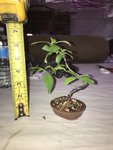A tidbit of history, buckthorn, Rhamus cathartica, is wildly invasive in midwestern USA forests and prairies. Where it gets a toe hold, in a short decade or two it can convert a tall grass prairie patch into a desolate mono-culture of nothing but buckthorn. In Europe, the UK and its native areas, it is reasonably well behaved. The reason it seems to be so invasive in USA is that it partnered with a different mycorrhiza species than it normally does in the EU. The new relationship is hugely beneficial to buckthorn at the expense of surrounding vegetation. Many of the prairie remnants in Illinois and Wisconsin have been destroyed or severely damaged by being over-run by buckthorn. Prairie restoration groups, "friend's of the Prairie" etc have monthly work days where most of the year they are focused on removing invasive species, mainly buckthorn, garlic mustard and autumn olive.
The phenomena of pairing with different mycorrhiza species conferring extra vigor and invasiveness has occurred a number of times. Buckthorn, Oriental Bittersweet, Autumn Olive all seem to get their "extra vigor" from pairing with local mycorrhiza that are not found in their native ranges. The ability to be less selective in choice of mycorrhiza in one of the hallmarks that identifies species as being potentially invasive.
Buckthorn was introduced to the USA by Dr. John Kennicott who settled in Glenview IL, in 1836. In 1856 the now prospering Dr. Kennicott built his "big house" the one that currently is being restored by the Glenview Park District. Dr. Kennicott missed his homeland Scotland and sometime around 1860 imported the first living buckthorn into the USA to plant on his property in Glenview IL. So it was a damn Scotsman that unleashed this vegetable scourge upon North America, and he let it loose in Glenview, the north suburbs of Chicago.
So now you know everything I know about buckthorn as bonsai. I have never tried it for bonsai because I can't stand looking at it. I have spent a fair number of work days volunteering at Chiwaukee prairie, and other prairies, ripping out buckthorn, and really can not stand looking at it.
Using invasive species for bonsai is a good thing, as we tend to kill a lot of our early attempts. Anything that leads to a shortened life span for buckthorn is good in my book.




